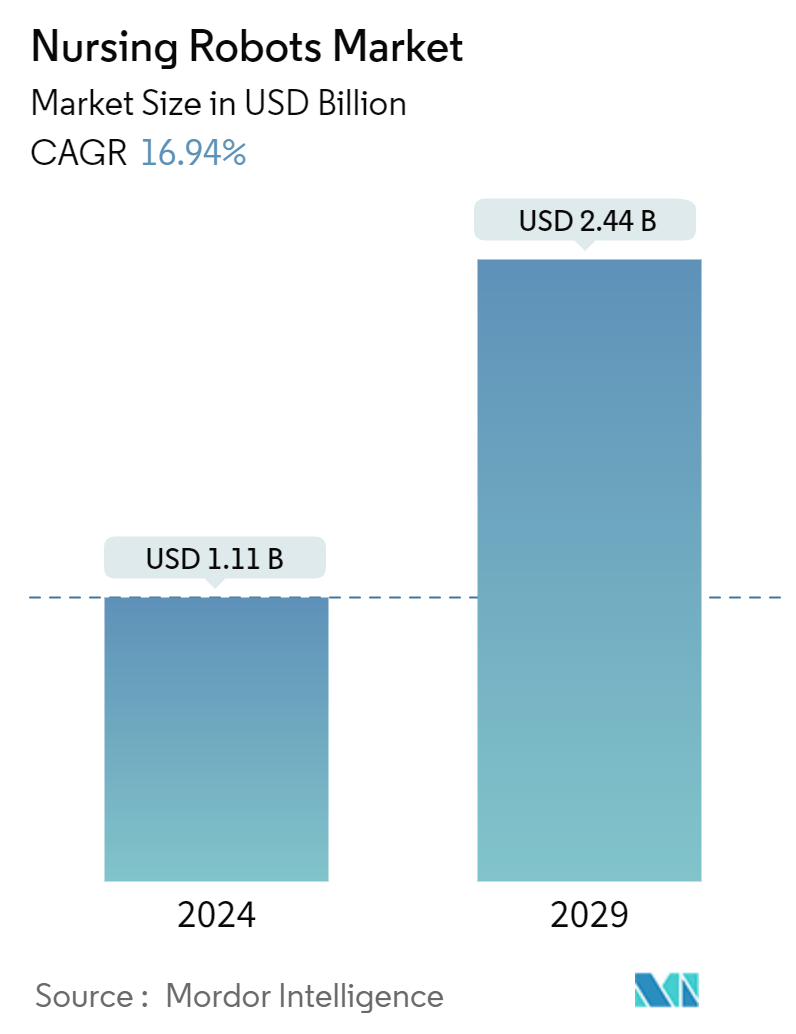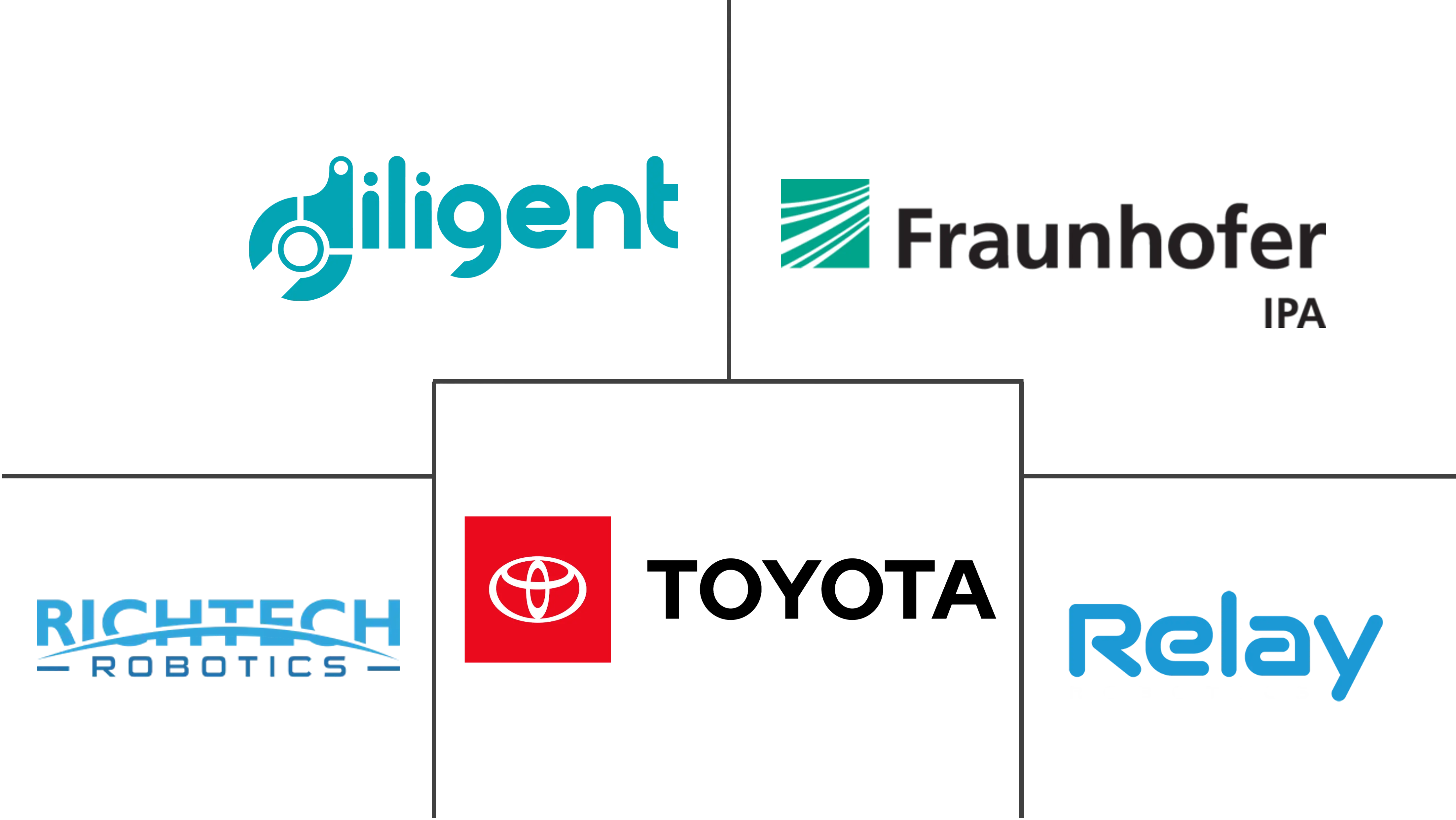Market Size of Nursing Robots Industry

| Study Period | 2019 - 2029 |
| Market Size (2024) | USD 1.11 Billion |
| Market Size (2029) | USD 2.44 Billion |
| CAGR (2024 - 2029) | 16.94 % |
| Fastest Growing Market | Asia Pacific |
| Largest Market | North America |
Major Players
*Disclaimer: Major Players sorted in no particular order |
Nursing Robots Market Analysis
The Nursing Robots Market size is estimated at USD 1.11 billion in 2024, and is expected to reach USD 2.44 billion by 2029, growing at a CAGR of 16.94% during the forecast period (2024-2029).
Factors such as an increasing shortage of nursing staff coupled with a growing geriatric population, rising investment in the development of nursing robots, and technological advancements in robotics and artificial intelligence are expected to boost the growth of the nursing robots market during the forecast period.
The healthcare industry stands at a pivotal moment, grappling with a nursing shortage that jeopardizes patient care and further strains an already burdened system. For instance, the Nursing Shortage 2024 report revealed that over 60% of nurses in the United States reported feeling burnt out, with 22% having switched positions in the last six months. Furthermore, as of 2024, 47.8% of the US hospitals reported a vacancy rate exceeding 10%. Consequently, this nursing shortage across facilities is driving the rising demand for nursing robots, which is expected to fuel the market's growth.
Furthermore, in recent decades, Japan has increasingly embraced the use of robots in nursing homes. Initially brought in to handle routine tasks like lifting patients and dispensing medication, these robots have expanded their repertoire since then. They now offer companionship and entertainment, monitor vital signs, and even facilitate communication with healthcare professionals.
For instance, a May 2024 article published in Technology and Culture highlighted that the Japanese government is investing in the development of elder care robots. This initiative aims to counter a projected shortfall of 380,000 specialized personnel by 2025. Given these advancements and the aging population, robots are poised to play an even more pivotal role in Japan's nursing homes, addressing the increasing demand for elderly care services. This trend is expected to bolster the market's growth during the forecast period.
Moreover, technological advancements have positioned nursing robots as valuable partners in addressing understaffing and enhancing patient care in hospitals. With artificial intelligence (AI) demonstrating its reliability and effectiveness in clinical environments, hospitals are increasingly embracing nursing robotic solutions. This trend is driving a surge in demand for nursing robots, fueling the market's growth during the forecast period.
For instance, in June 2024, researchers from Tsinghua University introduced China’s first AI hospital, Agent Hospital. This pioneering establishment aims to transform healthcare through artificial intelligence. Agent Hospital features virtual doctors, nurses, and patients, all driven by advanced large language model (LLM) agents. These intelligent agents can replicate the complete diagnostic and treatment journey, enabling rapid and efficient patient care. Consequently, the rise of such AI-centric hospitals amplifies the demand for nursing robots, which specialize in patient monitoring and fundamental care. This trend underscores the growing allure of robotics in an increasingly tech-oriented healthcare landscape, further accelerating the market's growth.
Moreover, as hospitals increasingly conduct pilot programs for nursing robots, companies and researchers are being spurred to develop advanced nursing robots, driving the market's growth. For instance, in June 2023, Laakso Hospital in Finland initiated a three-month pilot program with a telerobot named Välkky. This robot has electronic skin technology, enabling it to transmit tactile sensations like pressure and vibration. Välkky's capabilities include handling patient meals, repositioning medical devices, and brushing hair. Such programs are poised to enhance the availability of nursing robots in hospitals, further propelling the market's growth during the forecast period.
Therefore, due to the shortage of nurses, increasing investment in the development of nursing robots, and the deployment of advanced nursing robots across hospitals, the studied market is expected to grow during the forecast period. However, the high cost of implementation, data privacy and security concerns, and stringent regulatory guidelines are likely to impede the market's growth during the forecast period.

